
This time it’s a quest for torque. Luckily, we got horsepower as a bonus. By the time we were done hangin’ a few speed parts off of a brand-new GM Performance Parts HT383 crate engine, it made 500 lb-ft at 4,200 rpm and 460 hp at 5,400 rpm. That’s gruntin’ for a daily driveable 383.
The HT383 has been available for a couple years now, but we’ve yet to see even one in a car, and we kinda wonder why. It’s probably because GMPP markets it as a “high-torque truck engine” with 325 hp at 4,500 rpm and 415 lb-ft of torque at 3,500. Most speed freaks will shun the truck connotation and guffaw at those power numbers, opting instead for GM’s aluminum-headed Fast Burn 350 that makes 385/385 for just an extra Franklin over the HT383’s typical mail-order price. However, we’ll show you that an out-of-the-box HT383 is no slouch, and just a few well-chosen add-ons can make it scream. Best of all, you can add the stuff as your budget allows.
But first, buy the engine. It’s PN 12497317, available for $3,895 from Scoggin-Dickey. The HT383 comes as a complete long-block with all the tin plus a water pump and an aluminum dual-plane intake. It’s based on a brand-new production block with four-bolt mains and a one-piece rear-main seal plus a set of the highly touted Vortec iron heads with 62cc chambers that mate with hypereutectic pistons (18cc dish, 0.026 in the hole) for 9.1:1 compression. The cam is a very tiny hydraulic roller with 196/207 duration at 0.050 with 0.431/0.451 lift. The rods are powdered metal, but the crank is forged.
Most curiously, the HT383 uses a slightly different combo than the pedestrian 383 kits. Whereas a typical stroker uses a 400-Chevy-type crank with 3.750 stroke in a 350-type block with 4.030 bore, the new GM crate engine has a standard bore of 4.000 inches with a longer 3.800 stroke. The rods are 5.7 inches, which is stock for a 350. We initially considered comparing the 3.8-inch-stroke HT383 to an otherwise identical 3.750-stroke 383, but decided the 0.050 additional stroke length just wouldn’t make that big of a difference in torque. We may be wrong, as our tuned-up crate engine made more average torque than our dyno guys had ever seen from a low-compression 383.
Check out the links below to learn how.
Step One: Get It Running
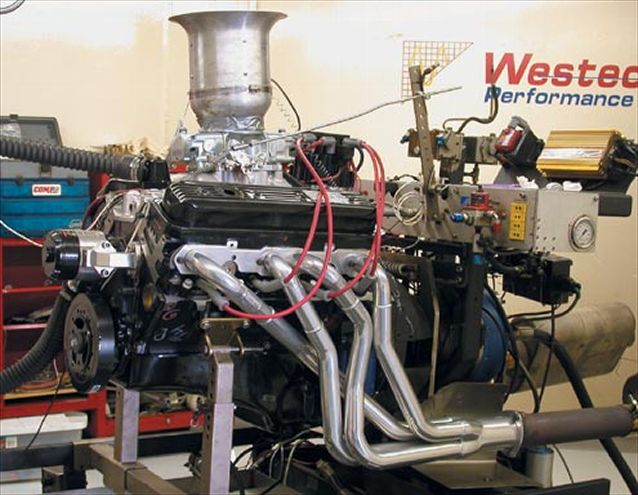 GM recommends a 750 carb for the HT383, but we've had such great luck with the little 625-cfm Road Demon that we used it for the initial run-in and first few stages of testing the engine.
GM recommends a 750 carb for the HT383, but we've had such great luck with the little 625-cfm Road Demon that we used it for the initial run-in and first few stages of testing the engine.
Your new HT383 will come out of the box complete with valve covers, a timing cover, an oil pan, an iron water pump, an 8-inch harmonic balancer, an auto-trans flexplate, and a dipstick. You'll need to provide a carb, ignition, and headers, which we did with components from Demon, Pertronix, and Hedman. We also opted to upgrade the stock oil pan with a Milodon claimer pan that has an integral windage tray, because we've found them to add a few horsepower. We were surprised to discover that the HT383 comes with both a partial windage tray and a full pan baffle, so in back-to-back tests, the Milodon unit didn't help us out this time. With the timing set to 34 degrees (36 degrees produced the same power), the jets at 70/76, and an electric water pump in place, the HT383 overdelivered on the dyno, spitting out 338 hp at 4,400 rpm and 444 lb-ft at 3,400 rpm. That's more than GM claims, with peaks 100 rpm lower than advertised. Perfect. Stab it in a big ol' heavy 3,600-pounder - even with a mild TH350 and tame 3.00 rear gears - and we'd expect you to run in the mid 13s.
Power
Peak HP: 338.1 @ 4,400
Peak Torque: 444.3 @ 3,400
Average HP 2,500-4,800: 292.6
Average Torque 2,500-4,800: 424.0
Torque at 2,500: 431 lb-ft
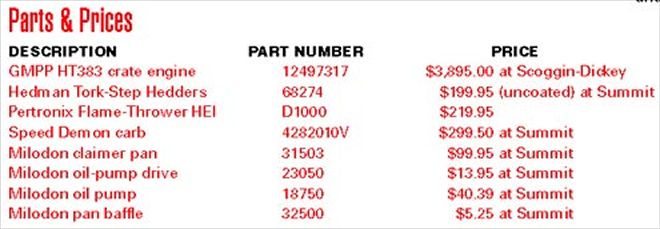
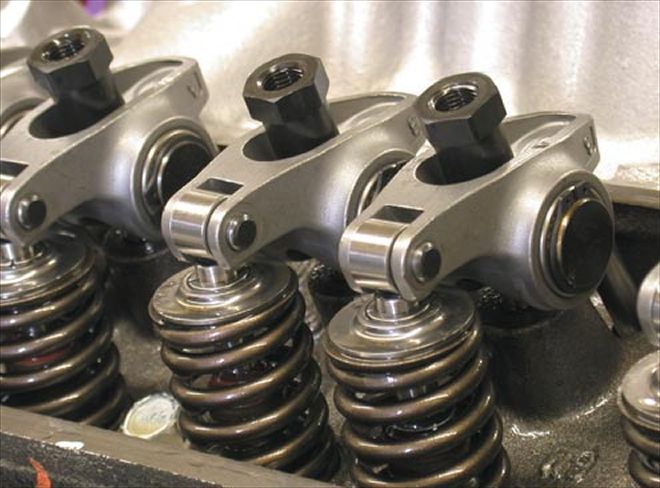 The Pro Magnum rockers are lightweight stainless steel and feature roller tips and trunions. The HT383 requires late-model-style guided rocker arms; because there are no pushrod guide plates or guide holes in the heads, the rockers need a grooved tip to center themselves on the valve tips. Comp now offers guided roller rockers in both 1.52:1 and 1.6:1 ratios for Chevy V-6s and small-block V-8s. The only problem with the rockers is that their width caused interference with the internal supports of the center-bolt-style factory valve covers. You'll either need to buy cast-aluminum covers with no brackets inside, or do like us and cut up the stockers with tin snips.
The Pro Magnum rockers are lightweight stainless steel and feature roller tips and trunions. The HT383 requires late-model-style guided rocker arms; because there are no pushrod guide plates or guide holes in the heads, the rockers need a grooved tip to center themselves on the valve tips. Comp now offers guided roller rockers in both 1.52:1 and 1.6:1 ratios for Chevy V-6s and small-block V-8s. The only problem with the rockers is that their width caused interference with the internal supports of the center-bolt-style factory valve covers. You'll either need to buy cast-aluminum covers with no brackets inside, or do like us and cut up the stockers with tin snips.
Step Two: 1.6:1 Rockers
With just 196/207 duration at 0.050, the HT383’s original cam is about the tiniest we’ve seen in a crate engine (the same as a Ram Jet 350’s). We’ve flow-tested the Vortec heads in the past and knew they’d enjoy more lift, and we suspected that a simple change to 1.6:1 roller rocker arms would give us more power at every rpm point with zero sacrifice. In addition to the quicker rate of lift provided by the 1.6:1 rockers, they would also increase total lift to 0.459/0.481 as compared to 0.431/0.451 with the stock 1.52:1 rockers. Sure enough, a set of Comp Cams Pro Magnum 1.6:1 rollers gained 17 hp and 8.2 lb-ft at peak and didn’t lose power anywhere in the curve. The fact that the rpm at peak increased by 100 and 300 rpm, respectively, told us that the engine would still like more cam.
Later on in the test, when we switched to a bigger camshaft (see Step Five), we tried a set of Comp’s similar 1.5:1 rollers, thinking perhaps the new cam had enough lift to not need the help of 1.6:1 rockers. We were wrong: This engine preferred the 1.6:1 Pro Magnums every step of the way.
Power
Peak HP: 355 @ 4,700
Peak Torque: 452.5 @ 3,500
Average HP 2,500-4,800: 300.3
Average Torque 2,500-4,800: 434.3
Torque at 2,500: 436.3
Step Three: RPM Air Gap Intake
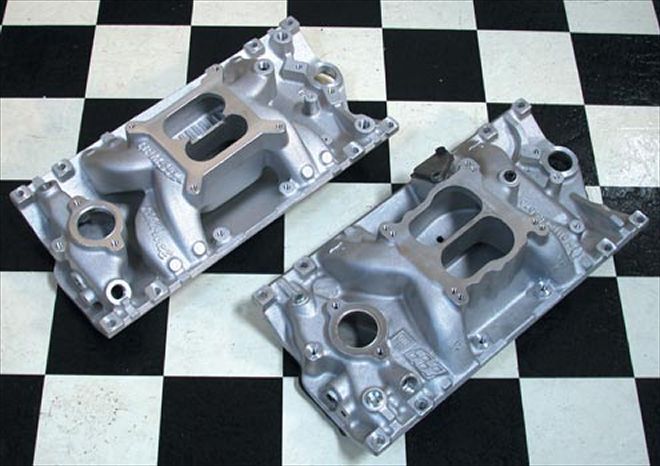 Here's the GM EGR intake (front) compared to the Edelbrock Air Gap, which is about 1/2-inch taller. The RPM Air Gap manifolds have runners that are separated from the engine's valley pan to keep hot oil off of them. That's more of a benefit in the car than on the dyno, but we've found the Air Gaps to be just slightly more powerful than the standard Performer RPMs in either case. A Vortec-style intake manifold is required for the HT383 engine, but we were able to reuse the original intake gaskets.
Here's the GM EGR intake (front) compared to the Edelbrock Air Gap, which is about 1/2-inch taller. The RPM Air Gap manifolds have runners that are separated from the engine's valley pan to keep hot oil off of them. That's more of a benefit in the car than on the dyno, but we've found the Air Gaps to be just slightly more powerful than the standard Performer RPMs in either case. A Vortec-style intake manifold is required for the HT383 engine, but we were able to reuse the original intake gaskets.
We've yet to test a street-performance small-block Chevy that didn't run best with an Edelbrock Performer RPM intake, and the Air Gap versions might even be a bit better. Compared to Edelbrock's other manifolds, the RPM and RPM Air Gap seem to provide nearly the same peak horsepower as a Victor Jr. single-plane, but with significantly more torque than even the standard Performer dual-plane. It's a best-of-both-worlds deal, a claim supported by the results on the HT383.
The crate engine is delivered with a medium-rise dual-plane intake with EGR provision. Traditional thinking is that smaller intake volume tends to boost low-end torque, yet a swap to the high-rise RPM Air Gap dual-plane made 10-20 more lb-ft and 5-40 extra horsepower. The 70/76 jetting in the Road Demon still seemed optimal.
Also, check this out: We've found that a 1-inch carb spacer is generally worth a dollop of horsepower, but not on this particular combo. We tried both four-hole and open spacers on the HT383, with both the carbs we tested and both the camshafts, and they weren't ever worth squat. In fact, the four-hole killed a whopping 25 lb-ft in one test. So for this engine, don't use a spacer.
Power
Peak HP: 370.0 @ 4,600
Peak Torque: 466.6 @ 3,700
Average HP 2,500-4,800: 309.9
Average Torque 2,500-4,800: 447.1
Torque at 2,500: 442.5

Step Four: Demon 750 Carb
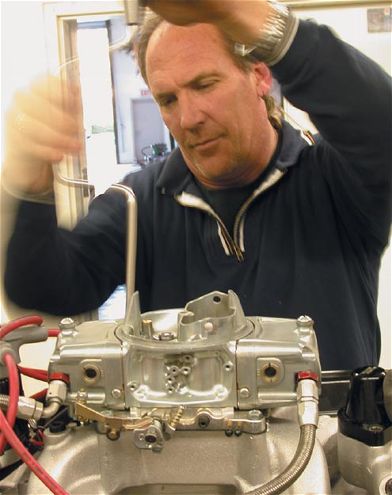 Pricewise, the 750 Speed Demon with mechanical secondaries is $439, about $194 more than the 625 Road Demon. The 750 would likely be a fine first choice for the HT383, and clearly more flexible at bigger power levels. The vacuum- secondary 750 Speed Demon VE, at $399, would also be a good pick.
Pricewise, the 750 Speed Demon with mechanical secondaries is $439, about $194 more than the 625 Road Demon. The 750 would likely be a fine first choice for the HT383, and clearly more flexible at bigger power levels. The vacuum- secondary 750 Speed Demon VE, at $399, would also be a good pick.
GM suggests a 750-cfm carb for the HT383; we second-guessed that and used a 625-cfm Road Demon up to this point. We’ve seen the Road Demon support more than 400 hp on a 400-plus-ci engine, so we still don’t think it’s a bad choice. However, we felt obligated to try the 750 Speed Demon (this one with mechanical secondaries) and were rewarded with another nice power gain. As with every mod we’d done so far, we gained torque at every single point in the power curve. This time the power peaks increased by a pleasant 9.4 and 7.7 lb-ft. With the 750 atop the 383, we had a brag-worthy 450 lb-ft at a meager 2,500 hp. That’s street-smokin’ power.
As for jetting, it’s interesting to note that the bigger carburetor liked 81/88 jetting compared to the 625’s 70/76 setup. Yet, judging by the Superflow dyno, both carbs used the same pounds-per-hour of fuel throughout the rpm curve. It seems that the smaller venturii of the 625 Road Demon create more of a pressure drop, thereby sucking harder on the jets and pulling more fuel. The more open throats of the 750 have less airspeed, thereby requiring bigger jets to move the same amount of fuel. Consider that during your next carb swap.
Power
Peak HP: 379.4 @ 4,600
Peak Torque: 474.3 @ 3,700
Average HP 2,500-4,500: 316.3
Average Torque 2,500-4,500: 456.3
Torque at 2,500: 449.9
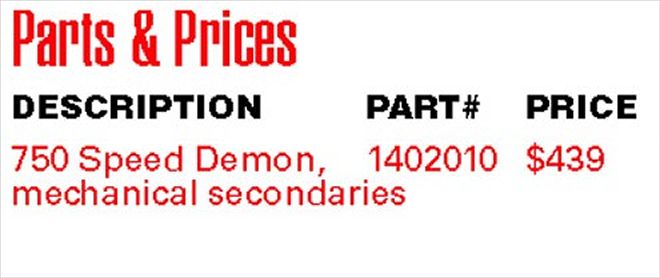
Step Five: Bigger Cam
The HT383 responded impressively to external bolt-ons. With total investment of about $5,300 with the headers, ignition, and upgraded rockers, carb, and intake, it makes a serious 380 hp and 474 lb-ft with very flat power curves that’d put a smirk on your mug in any street car or tow vehicle. We made 54 extra horsepower and 59 more lb-ft compared to the HT383’s advertised numbers. You’d be lame if you couldn’t get a 3,600-pound car to run in the 12s with this engine, a TH350 (no expensive overdrive), and 3.50:1 gears.
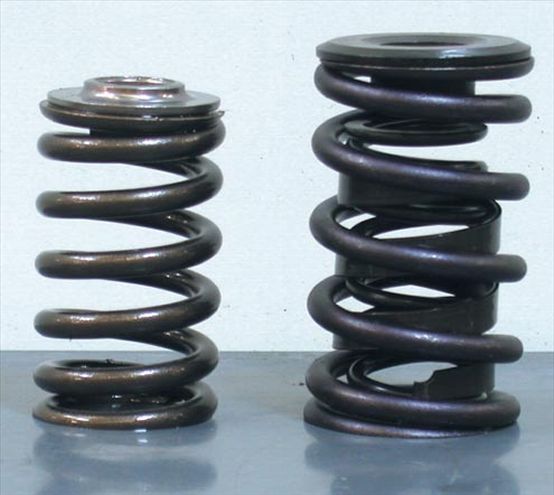 The stock Vortec spring on the left has a 0.980 diameter while the replacement Comp Cams spring is 1.430, requiring the spring seat in the heads to be enlarged.
The stock Vortec spring on the left has a 0.980 diameter while the replacement Comp Cams spring is 1.430, requiring the spring seat in the heads to be enlarged.
But we always want more. This time, we tore into the HT383 to try a bigger camshaft—namely a Comp Cams XE282HR in place of the original hydraulic roller. The new cam had 230/236 duration at 0.050 and 0.510/0.520 lift (or 0.544/0.555 with our 1.6:1 rockers) with a 110-degree lobe-separation angle. The HT383 uses ’87-’98-type factory roller-cam hardware and requires a step-nosed cam to accommodate the factory-style cam retainer. And because the HT383’s stock Vortec valvesprings and guides can’t take more than about 0.490 lift (sometimes less), we sent the heads to Dougan’s Machine to have the seats enlarged for Comp’s specified springs. Since the heads were off anyway, we replaced the gaskets with Fel-Pro rubber-coated steel shims to bump the compression ratio to 9.6:1 from the original 9.1:1.
The reward was a whopping 76 hp and 19 lb-ft. Of course, the cam changed the entire character of the engine; the rpm at peak increased by 1,000 rpm (horsepower) and 500 rpm (torque). A 4,800-rpm- redline engine became a 5,800-rpm buzz. Sadly, the larger cam gave up as much as 25 lb-ft of torque at every data point below 3,600 rpm, yet with 426 lb-ft at 2,500 rpm, it was still no low-end slouch. Also, whereas it formerly idled at 650 rpm and 19 inches of vacuum, the new cam idled at 950 and 12 inches. The tiny cam idled like the Rock of Gibraltar, but we felt the XE282 was acceptably streetable.
Ultimately, the XE282 cam and the half-point bump in compression changed this 383 from an ideal towing/daily driver engine to a hot rod engine that could easily be driven anywhere with some nice bragging rights. It’ll turn our theoretical 3,600-pound land yacht into a beast that’ll probably go 11s on slicks, though the new power curve might prefer 3.73 rear gears.
Power
Peak HP: 455.3 @ 5,600
Peak Torque: 493.0 @ 4,200
Average HP 2,500-4,800: 327.4
Average Torque 2,500-4,800: 467.7
Average HP 4,000-5,700: 427.4
Average Torque 4,000-5,700: 465.3
Torque at 2,500: 426.3
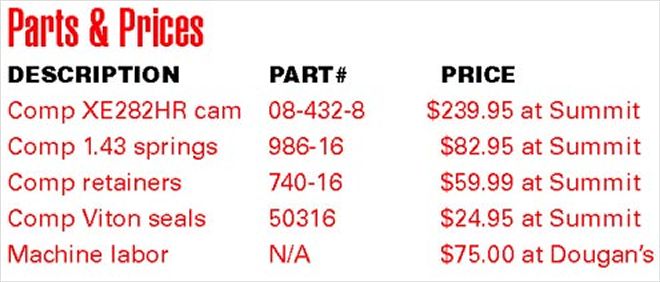
Step Six: Slippery Oil
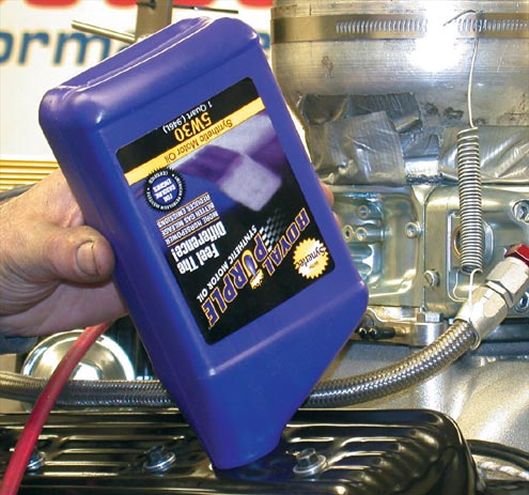 The spec oil for the HT383 is 5W30, so we tried it in a full-synthetic blend from Royal Purple, one of the more affordable brands of synth. We were so impressed that we're planning a full chassis-dyno test of Royal Purple products for the engine, trans, rearend, and wheel bearings.
The spec oil for the HT383 is 5W30, so we tried it in a full-synthetic blend from Royal Purple, one of the more affordable brands of synth. We were so impressed that we're planning a full chassis-dyno test of Royal Purple products for the engine, trans, rearend, and wheel bearings.
We were so close to 500 lb-ft that we decided to pull out the magic wand: synthetic oil. It’s generally worth a few power numbers, so we drained the 10W30 dinosaur sauce and poured in Royal Purple’s 5W30 street oil (lighter-weight racing oil is also available). It took three dyno pulls for the synthetic to do its thing, then it made the repeatable power we wanted: 502.9 lb-ft and 463 hp. As an average from 2,500 to 5,800 rpm, the Royal Purple bought us 7 hp and 10 lb-ft. Combined with the extra engine protection and heat resistance, this is a no-brainer.
Power
Peak HP: 463.1 @ 5,600
Peak Torque: 502.9 @ 4,200
Average HP 2,500-4,800: 334.8
Average Torque 2,500-4,800: 478.1
Average HP 4,000-5,700: 436.4
Average Torque 4,000-5,700: 475.1
Torque at 2,500: 434.7
Accessory Pulley Shootout
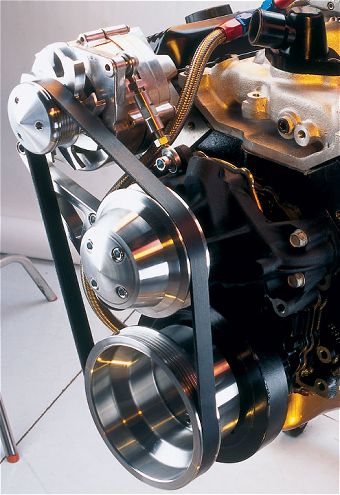
We've seen lots of articles about underdrive accessory pulleys for late- model cars, but you may not be aware that March Performance also sells them for carbureted performance applications. In the case of the long-water-pump small-block Chevy, you've got a choice of Performance Ratios or High Water Flow Ratios in either V-belt or six-rib-belt designs. Either way, you can use March's high-performance alternator brackets, as seen on this month's cover, to replace the ungainly stock bracket.
While March always recommends High Flow pulleys for stroker applications such as the HT383, or for nearly any real street car, we decided to compare them to the Performance Ratio set on the dyno. March warned that the biggest power gains are seen when underdriving accessories such as power steering, smog pumps, and air conditioning, but we tried them with an alternator alone. First came the Performance Ratio, and to our surprise, it made perhaps one horsepower less than the electric water pump. Call that testing variance. For practical purposes, it was the same. However, the High Flow Ratio must truly flow more water, since it drew an extra 7 hp and 7 lb-ft on average throughout the curve. We'd gladly give that up for the extra cooling; it's nothing like the horror stories we've heard of losing 20 hp to a water pump.